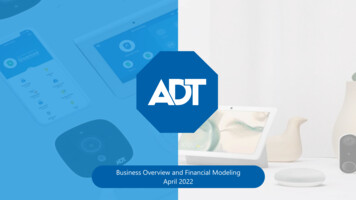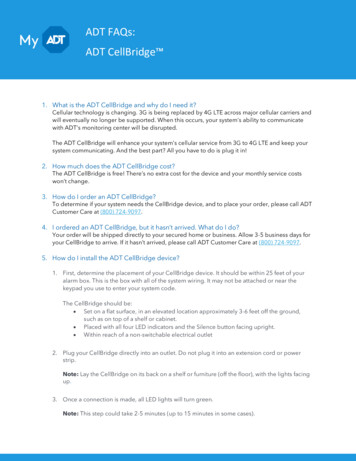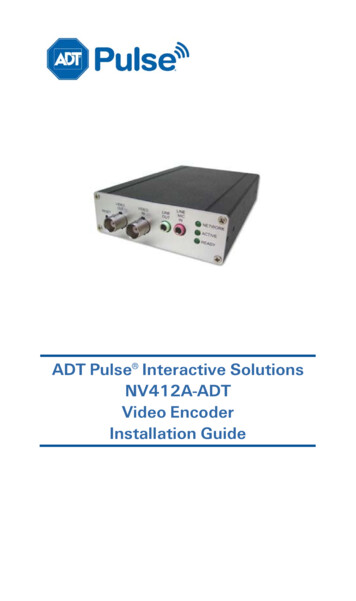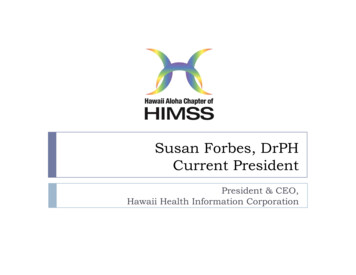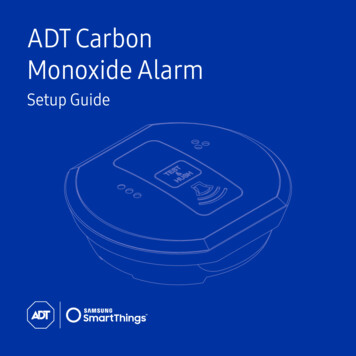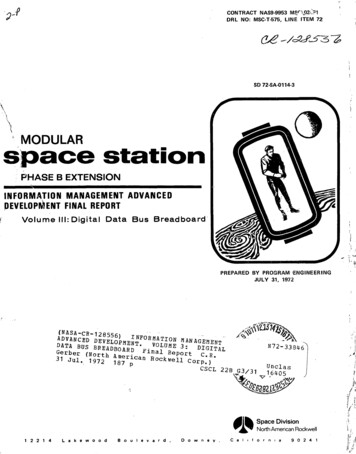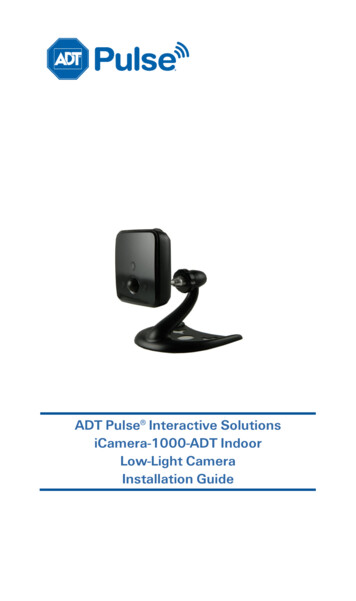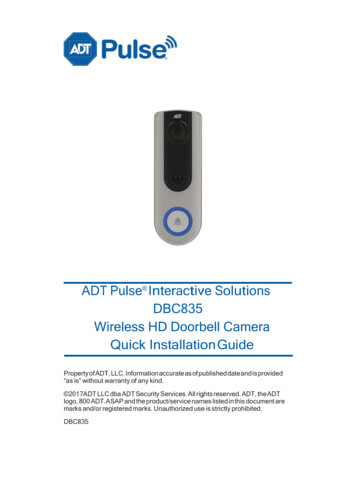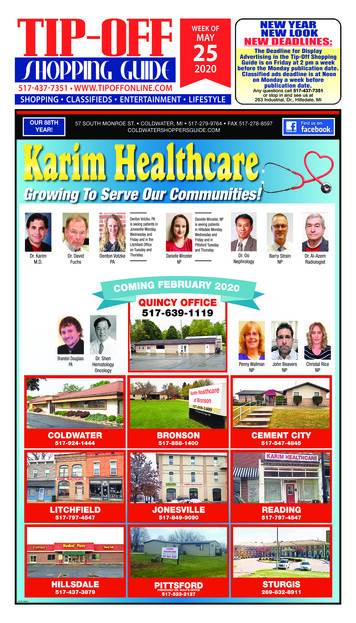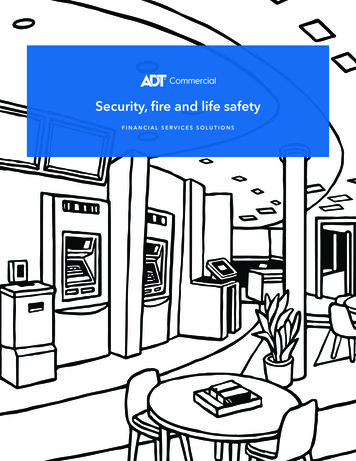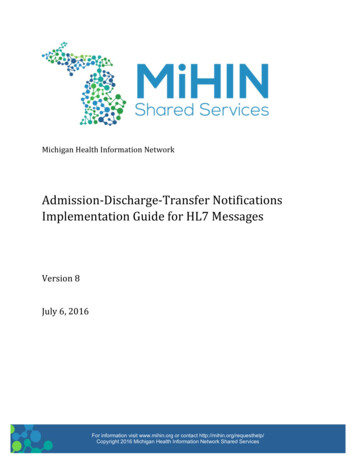
Transcription
Michigan Health Information NetworkAdmission‐Discharge‐Transfer NotificationsImplementation Guide for HL7 MessagesVersion 8July 6, 2016For information visit www.mihin.org or contact http://mihin.org/requesthelp/Copyright 2016 Michigan Health Information Network Shared Services
Document HistorySection(s)DateVersion Revised07/05/13 0.1All07/12/13 0.2All07/29/13 0.3All09/13/13 0.4All10/05/13 0.5All10/16/13 0.6All02/18/14 1.0All04/10/14 2.0All06/12/14 ptionDraft version 0.1Draft version 0.2Draft version 0.3Draft version 0.4Draft version 0.5Draft version 0.6Version 1.0Version 2.0Changed DOC and SS#descriptionsAllChanged IN1 RE to RAllAdded Use Case ReminderAllAdded onboarding sectionAllAdded mapping tables,conformance requirementsAllReview, edit contentAllEdit of the documentSection 1.2 Added Message ContentAllNew template, definitions addedAllFormatting workModifierD. LivesayS. SouthardS. SouthardS. SouthardS. SouthardFor information visit www.mihin.org or contact http://mihin.org/requesthelp/Copyright 2016 Michigan Health Information Network Shared Services
Table of ContentsAcronyms and Abbreviations Guide. 1Definitions . 21 Introduction . 61.1 Purpose of Use Case. 61.2 Message Content . 71.3 Data Flow and Actors . 72 Onboarding . 92.1 Prerequisites. 92.1.1 Universal Legal Prerequisites . 92.1.2 ADT Receiver Use Case Prerequisites . 92.1.3 ADT Notification Diagram . 102.2 Sending ADT Notifications. 102.2.1 ADT Sender Onboarding Process . 112.3 Receiving ADT Notifications . 122.3.1 ADT Receiver Onboarding Process. 122.3.2 MiHIN Appended Z‐Segments. 133 Specifications . 143.1 Sending Organization Requirements . 143.1.1 Segment Requirements for Sending Organization . 143.1.2 Segment Usage Requirements for Sending Organization . 143.1.3 Field and Subfield Requirements for Sending Organization . 153.1.4 Mapping Tables . 153.1.5 Conformance Reporting . 163.2 Receiving Organization Requirements. 173.2.1 Segment Requirements for Receiving Organization . 173.2.2 Segment Usage Requirements for Receiving Organization . 173.2.3 Field and Subfield Requirements for Receiving Organization. 173.2.4 Acknowledgment Message Requirements for Receiving Organization . 184 Static Definition – Message Level . 194.1 ADT (Patient Administration) Message – Trigger Events A01, A04, A05, A08, A13,A14, A28, A31 . 194.2 ADT (Patient Administration) Message – Trigger Events A02, A21, A22, A23, A25,A26, A27, A29, A32, A33 . 204.3 ADT (Patient Administration) Message – Trigger Event A03 . 214.4 ADT (Patient Administration) Message – Trigger Events A06, A07. 224.5 ADT (Patient Administration) Message – Trigger Events A09, A10, A11, A15. 234.6 ADT (Patient Administration) Message – Trigger Event A12 . 234.7 ADT (Patient Administration) Message – Trigger Event A17 . 244.8 ADT (Patient Administration) Message – Trigger Event A20 . 24For information visit www.mihin.org or contact http://mihin.org/requesthelp/Copyright 2016 Michigan Health Information Network Shared Services
4.9 ADT (Patient Administration) Message – Trigger Events A24, A37. 254.10 ACK (Acknowledgment) Message . 255 Static Definition – Segment Level . 265.1 MSH (Message Header) Segment . 265.2 SFT (Software) Segment . 275.3 EVN (Event Type) Segment . 275.4 PID (Patient Identification) Segment . 285.5 PD1 (Additional Demographics) Segment . 295.6 PV1 (Patient Visit) Segment . 305.7 OBX (Observation / Result) Segment . 325.8 DG1 (Diagnosis Information) Segment . 335.9 PR1 (Procedures) Segment . 345.10 IN1 (Insurance) Segment . 355.11 NPU (Non‐Patient Update) Segment . 375.12 MSA (Message Acknowledgment) Segment . 375.13 ERR (Error) Segment . 376 Static Definition – Field Level . 396.1 MSH (Message Header) Segment Fields . 396.2 SFT (Software) Segment Fields . 426.3 EVN (Event Type) Segment Fields . 436.5 PD1 (Additional Demographics) Segment Fields . 496.6 PV1 (Patient Visit) Segment Fields . 506.7 OBX (Observation / Result) Segment Fields . 546.8 DG1 (Diagnosis Information) Segment Fields. 556.9 PR1 (Procedures) Segment Fields. 566.10 IN1 (Insurance) Segment Fields . 596.11 NPU (Non‐Patient Update) Segment Fields . 616.12 MSA (Message Acknowledgment) Segment Fields. 626.13 ERR (Error) Segment Fields . 627 HL7 Vocabulary Tables . 65Table 0001: Sex . 65Table 0003: Event Type . 65Table 0004: Patient Class . 66Table 0005: Race . 66Table 0007: Admission Type . 66Table 0008: Acknowledgment Code . 67Table 0010: Physician ID . 67Table 0018: Patient Type. 67Table 0023: Admit Source . 67Table 0051: Diagnosis Code . 68Table 0052: Diagnosis Type . 68Table 0053: Diagnosis Coding Method . 68Table 0069: Hospital Service . 68Table 0072: Insurance Plan ID . 68For information visit www.mihin.org or contact http://mihin.org/requesthelp/Copyright 2016 Michigan Health Information Network Shared Services
Table 0076: Message Type . 68Table 0085: Observation Result Status Codes Interpretation . 69Table 0088: Procedure Code . 69Table 0089: Procedure Coding Method. 69Table 0104: Version ID . 70Table 0112: Discharge Disposition . 70Table 0113: Discharged to Location . 71Table 0116: Bed Status . 71Table 0125: Value Type . 71Table 0136: Yes/No Indicator . 71Table 0189: Ethnic Group. 71Table 0302: Point of Care . 71Table 0303: Room . 72Table 0304: Bed . 72Table 0305: Person Location Type . 72Table 0306: Location Status . 72Table 0307: Building . 72Table 0308: Floor . 72Table 0357: Message Error Status Codes . 72Table 0361: Application . 73Table 0362: Facility . 73Table 0516: Error Severity . 738 Troubleshooting . 748.1 Production Support . 749 Legal Advisory Language . 75For information visit www.mihin.org or contact http://mihin.org/requesthelp/Copyright 2016 Michigan Health Information Network Shared Services
Acronyms and Abbreviations terfaceContinuity of CareDocumentClinical DocumentArchitectureCertified ElectronicHealth RecordTechnologyCommunity HealthAutomated MedicaidProcessing SystemCenters for Medicare& Medicaid ServicesData QualityAssuranceDirect SecureMessagingElectronic HealthRecordElectronic HealthRecord MedicaidIncentive PaymentProgramHealth Level SevenHealth ProviderDirectoryInternationalOrganization forStandardizationMichigan Departmentof Health and HumanServicesMedical InformationDirect GatewayMichigan HealthInformation NetworkShared ServicesMeaningful stration andAttestation SystemRepresentational StateTransferState of MichiganVirtual PrivateNetworkExtended Mark‐UpLanguageFor information visit www.mihin.org or contact http://mihin.org/requesthelp/Copyright 2016 Michigan Health Information Network Shared Services- Page 1 -
DefinitionsActive Care Relationship. (a) For health providers, a patient who has been seen by aprovider within the past 24 months, or is considered part of the health provider’sactive patient population they are responsible for managing, unless notice oftermination of that treatment relationship has been provided to HIN; (b) for payers,an eligible member of a health plan; (c) an active relationship between a patient andcare manager or other person or organization for the purpose of treatment,payment or operations; or (d) a relationship with a health provider asserted by aconsumer and approved by such health provider.Admission, Discharge, Transfer (ADT). An event that occurs when a patient isadmitted to, discharged from or transferred from one care setting to another caresetting or to the patient’s home. For example, an ADT event occurs when a patient isdischarged from a hospital and sent home. An ADT event also occurs when a patientarrives in care setting such as a health clinic or hospital.ADT Message. A type of HL7 message generated by healthcare systems based uponADT events; the HL7 ADT message type is used to send or receive patientdemographic and/or healthcare encounter information, generated from sourcesystem(s). The HL7 ADT messages contain patient demographic, visit, insurance anddiagnosis information.ADT Notification. An electronic notification that a given patient has undergone an ADTevent.Applicable Laws and Standards. In addition to the definition set forth in the DataSharing Agreement, the federal Confidentiality of Alcohol and Drug Abuse PatientRecords statute, section 543 of the Public Health Service Act, 42 U.S.C. 290dd‐2, andits implementing regulation, 42 CFR Part 2; the Michigan Mental Health Code, atMCLA §§ 333.1748 and 333.1748a; and the Michigan Public Health Code, at MCL §333.5131, 5114a.Caregiver. An individual such as a health professional or social worker who assists inthe identification, prevention or treatment of an illness or disability.Data Sharing Agreement. Any data sharing organization agreement signed by bothHIN and participating organizationElectronic Medical Record or Electronic Health Record. A digital version of apatient's paper medical chart.End Point. An instance of an electronic address or ESI.Exhibit. A use case exhibit or a pilot activity exhibit.Health Level 7 (HL7). An interface standard and specifications for clinical andadministrative healthcare data developed by the American National StandardsInstitute. HL7 provides a method for disparate systems to send and receive clinicalFor information visit www.mihin.org or contact http://mihin.org/requesthelp/Copyright 2016 Michigan Health Information Network Shared Services- Page 2 -
and administrative information in a normalized format with acknowledgement ofreceiptHealth Information. Any information, including genetic information, whether oral orrecorded in any form or medium, that (a) is created or received by a healthprofessional, health plan, public health authority, employer, life insurer, school oruniversity, or health care clearinghouse; and (b) relates to the past, present, orfuture physical or mental health or condition of an individual; the provision ofhealth care to an individual; or the past, present, or future payment for the provisionof health care to an individual.Health Information Network (HIN). An organization or group of organizationsresponsible for coordinating the exchange of protected health information (PHI) in aregion, state, or nationally.Health Plan. An individual or group plan that provides, or pays the cost of medical care(as defined in section 2791(a)(2) of the Public Health Service Act, 42 U.S.C. 300gg‐91(a)(2)). Health Plan further includes those entities defined as a health plan underHIPAA, 45 CFR 160.103.Health Professional or Health Provider. (a) Any individual licensed, registered, orcertified under Federal or State laws or regulations to provide health care services;(b) any person holding a non‐clinical position within or associated with anorganization that provides healthcare or healthcare related services; and (c) peoplewho contribute to the gathering, recording, processing, analysis or sending andreceiving of Health Information.Health Provider Directory. The statewide shared service established by HIN thatcontains contact information on health professionals, facility/hospital, otherhealthcare organizations, electronic addresses, end points, and electronic serviceinformation, as a resource for authorized users to obtain contact information andsecurely exchange health information.HIN Infrastructure Service. Certain services that are shared by numerous use cases.HIN Infrastructure Services include, but are not limited to, ACRS, HPD, StatewideConsumer Directory (SCD), and the Medical Information DIrect GATEway(MIDIGATE ).HIN Services. The HIN infrastructure services and additional services and functionalityprovided by HIN allowing the participating organization to send, receive, find, or useinformation to or from HIN as further set forth in an exhibit.Information Source. Any organization that provides information that is added to a HINInfrastructure Service.Meaningful Use. Using certified EHR technology to improve quality, safety andefficiency of healthcare, and to reduce health disparities.Message. A mechanism for exchanging message content between the participatingorganization to HIN services, including finding and receiving.For information visit www.mihin.org or contact http://mihin.org/requesthelp/Copyright 2016 Michigan Health Information Network Shared Services- Page 3 -
Message Content. Information which is sent, received, found or used by a ParticipatingOrganization to or from HIN Services, including, but not limited to, PHI, commonkeys, de‐identified data, metadata, Digital Credentials, and data schema. MessageContent includes the Message Content Header.Message Header. The MSH segment present in every HL7 message type that definesthe message's source, purpose, destination, and certain syntax specifics such asdelimiters (separator characters) and character sets. It is always the first segment inthe HL7 message, with the only exception being HL7 batch messages.Michigan Health Information Network Shared Services. The HIN for the State ofMichigan.Notice. A sent message that is not message content and which may include but not belimited to an acknowledgement of receipt or error response.Patient Data. Any data about a patient or a consumer that is electronically filed in aparticipating organization or organization’s systems or repositories. The data maycontain protected health information, personal credit information, or personallyidentifiable information.Person Record. Any record in a HIN Infrastructure Service that primarily relates to anindividual person.Provider Community. A healthcare provider with an active care relationship with theapplicable patient.Send / Receive / Find / Use. Means sending, receiving, finding, or using messagecontent. Sending involves transport of message content. Receiving involvesaccepting and possibly consuming/storing message content. Finding meansquerying to locate message content. Using means any use of the message contentother than sending, receiving and finding.Source System. A computer system, such as an electronic health record system, at theparticipating organization, that sends, receives, finds or uses message content ornotices.Statewide Consumer Directory. A HIN Infrastructure Service that helps organizationsprovide tools giving consumers the ability to manage how their personal HealthInformation can be shared and used. The SCD is essentially a Software DevelopmentKit with a robust set of FHIR APIs that can be used by online health portals, mobileapps, or any other consumer‐facing health applications that enable consumers totake an active role in viewing and editing their preferences for how their healthinformation is shared.Transactional Basis. The sending of message content or a notice within a period oftime of receiving Message Content or notice from a sending or receiving party asmay be further set forth in a specific exhibit.For information visit www.mihin.org or contact http://mihin.org/requesthelp/Copyright 2016 Michigan Health Information Network Shared Services- Page 4 -
Transitions of Care. The movement of a patient from one setting of care (e.g. hospital,ambulatory primary care practice, ambulatory specialty care practice, long‐termcare, rehabilitation facility) to another and can include transfers within a healthcareorganization.Trusted Data Sharing Organization. An organization that has signed any form ofagreement with HIN for data sharing.Use Case. A specific scenario or group of scenarios for sharing patient healthinformation.Use Case Exhibit. The legal agreement attached as an exhibit to the Master Use CaseAgreement that governs participation in any specific Use Case.Use Case Implementation Guide. The document providing technical specificationsrelated to Message Content and transport of Message Content between participatingorganizations, HIN, and other data sharing organizations. Use Case ImplementationGuides are made available via URLs in exhibits.Use Case Summary. The document providing the executive summary, businessjustification and value proposition of a use case. Use case summaries are providedby HIN upon request and are available via www.mihin.org.View Download Transmit. A requirement for Meaningful Use with the objective toprovide patients with the ability to view online, download and send their healthinformation within four business days of the information being available to anEligible Professional.For information visit www.mihin.org or contact http://mihin.org/requesthelp/Copyright 2016 Michigan Health Information Network Shared Services- Page 5 -
1 Introduction1.1 Purpose of Use CaseAdmission, Discharge, Transfer (ADT) notification is widely regarded as a keystone toimproving patient care coordination through health information exchange. ADTmessages are sent when a patient is admitted to a hospital, transferred to anotherfacility, or discharged from the hospital. Alerts are then sent to update physicians andcare management teams on a patient’s status, thus improving post‐dischargetransitions, prompting follow‐up, improving communication among providers, andsupporting patients with multiple or chronic conditions. ADT notifications also supportthe identification of patients who are frequent or high users of the health care system,which allows providers to steer these patients toward clinical and non‐clinicalinterventions that may reduce unnecessary overutilization by preventing avoidableemergency department visits and hospital readmissions.This use case supports a way to communicate the status of patients’ care transitionswith every care team member interested in that patient. When a patient is admitted to ahospital, transferred, or discharged, an ADT message is created by the hospital’sElectronic Health Record (EHR) system. The hospital EHR system sends the ADTmessages to the health information network (HIN) which operates the Statewide ADTNotification Service. The HIN then finds the patient and the providers who are on thatpatient’s care team using the Active Care Relationship Service (ACRS). ACRS containsinformation on which providers (e.g. attending, referring, consulting, admitting,primary care physician, etc.) are interested in that patient’s health. The HIN also findsthe providers in the statewide Health Provider Directory (HPD) to obtain the deliverypreference for each of those providers and to determine the electronic endpoint and“transport” method by which the providers wish to receive ADT notifications (e.g. viaDirect Secure Messaging, via Health Level Seven (HL7) over LLP, etc.) for their patients.Based on the provider’s delivery preferences, the HIN notifies each provider who has anactive care relationship with a patient upon the following ADT events: Patient is admitted to the hospital for inpatient or emerge
For example, an ADT event occurs when a patient is discharged from a hospital and sent home. An ADT event also occurs when a patient arrives in care setting such as a health clinic or hospital. ADT Message. A type of HL7 message generated by healthcare systems based upon ADT events; the HL7 ADT message type is used to send or receive patient

